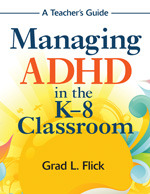Managing ADHD in the K-8 Classroom
A Teacher's Guide
- Grad L. Flick - Seacoast Psychological Association, The ADD Clinic
Managing ADHD in the K–8 Classroom offers the latest research-based information about characteristics, assessment, and behaviours associated with ADHD, and provides appropriate options for responding to children's challenging behaviour. This valuable resource features case studies, checklists, graphs, and specific strategies that help general and special education teachers:
- Make accommodations in the classroom
- Promote appropriate behaviour and discourage inappropriate behaviour
- Deal with children's impulsivity, attention problems, hyperactivity, difficulty following directions, and other problem behaviours related to ADHD
- Use relaxation and stress management techniques that strengthen teachers' ability to handle behavioural challenges.
"Another powerful resource by Flick, filled with a wealth of up-to-date and research-based information about ADHD, effective strategies and interventions for managing the disorder, and expert guidance to enable students with ADHD to achieve success."
"I found Flick's methods on removing inappropriate behaviors an invaluable tool that I used in my classroom management plan during my student teaching experience. The performance of my eighth-grade students with an ADHD IEP plan showed a marked improvement when I used the behavioral interventions. New teachers, as well as veteran teachers, will benefit from Flick's behavioral interventions; most importantly, student performance will be improved."
"Flick has once again given teachers the tools they need to be master behavioral technologists in the classroom. Every teacher in every classroom could benefit by reading this book. Those who teach particularly challenging children will benefit the most. By following Flick’s practical recommendations, teachers will be able to systematically employ behavioral strategies to effectively improve classroom behavior and attention, increase academic performance, and positively impact the self-esteem of students in their class."



